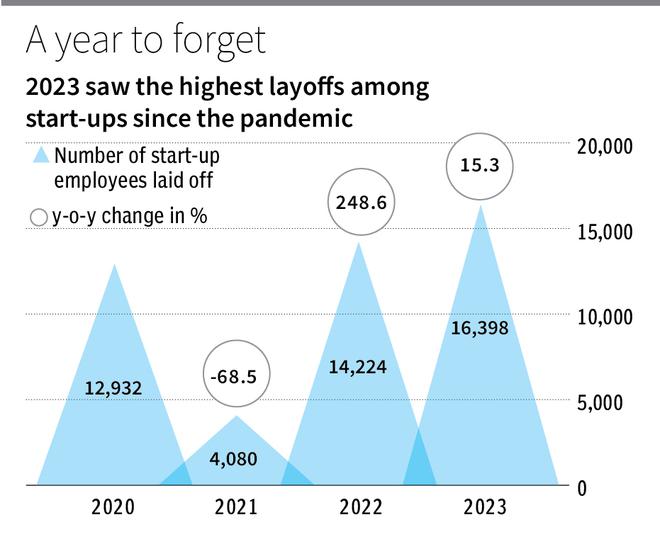As Indian start-ups struggled against lesser funding and more demanding investors in 2023, they seem to have continued to layoff employees in a bid to improve profitability. Recent data from layoffs.fyi indicates that layoffs were at an all-time high in 2023, with 16,398 start-up employees given the pink-slip. This number is 15 per cent higher than the number laid off in 2022.

This trend began during the pandemic with 12,932 people laid off in 2020. While there was a hiatus in the next year, layoffs again surged in 2022 with 14,224 start-up employees laid off.
India ranks second among countries which have witnessed the most start-up layoffs in the last four years. From 2020 to 2023, around 5.2 lakh people have been laid off from start-ups globally. While the US accounts for 66.6 per cent of the layoffs, India accounts for 9.1 per cent, followed by the Netherlands with a 3.4 per cent share. In 2023 too, India ranks second in the list with the US in the top place. The US laid off 1.7 lakh start-up employees in 2023, while Germany which is in the third place, laid off 13,128 people.
Factors responsible
According to Thillai Rajan, Professor in the Department of Management Studies at IIT-Madras, “One of the primary reasons behind the annual growth of mass layoffs in India could be the increasing ‘business evolution’. The emergence of new business opportunities creates a higher demand for new talent in the market. Hence, those who cannot fulfil the demands of the market or lack these new talents are automatically pushed out of the company, resulting in increasing layoffs.”

According to the data, Byju’s, PayTm, and RelianceJioMart are the top three start-ups that have laid off the most employees in India, with 2,500, 1,000, and 1,000 employees, respectively.
In 2023, the highest number of layoffs occurred in the education industry, involving 21 companies and totalling 4,730 layoffs. The food industry ranks second, with 13 companies laying off 2,765 people, followed by the finance industry with 18 companies and 2,141 layoffs.
Rajan points out, “During the Covid lockdown period, a new wave of learning emerged through virtual mediums. However, in the post-Covid period, these mediums are no longer needed as things are returning to normalcy. This shift could have resulted in more layoffs in the education industry.”

The Harvard Business Review states that layoffs, while seen as a short-term solution to lower costs, can have detrimental long-term effects on companies. Mass layoffs may lead to a decline in product quality as the remaining workforce faces increased workloads. Moreover, the reduction in the workforce can stifle innovation within the company, too.
In 2023, among the ten major cities in India, Bengaluru, Gurugram, and Mumbai top the ranks with the highest share of people being laid off, comprising 57.4 per cent, 13.4 per cent, and 9.8 per cent, respectively, in each city. This trend may be influenced by the significant presence of start-ups in these cities. According to the Ministry of Commerce and Industry, Maharashtra (13,519), Karnataka (8,881), and Delhi (8,636) have the most number of registered start-ups in India.




Comments
Comments have to be in English, and in full sentences. They cannot be abusive or personal. Please abide by our community guidelines for posting your comments.
We have migrated to a new commenting platform. If you are already a registered user of TheHindu Businessline and logged in, you may continue to engage with our articles. If you do not have an account please register and login to post comments. Users can access their older comments by logging into their accounts on Vuukle.